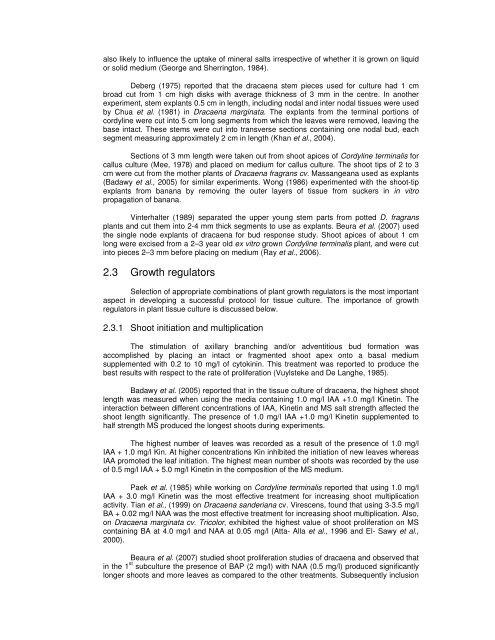micropropagation studies in dracaena and cordyline - ETD ...
micropropagation studies in dracaena and cordyline - ETD ...
micropropagation studies in dracaena and cordyline - ETD ...
You also want an ePaper? Increase the reach of your titles
YUMPU automatically turns print PDFs into web optimized ePapers that Google loves.
also likely to <strong>in</strong>fluence the uptake of m<strong>in</strong>eral salts irrespective of whether it is grown on liquid<br />
or solid medium (George <strong>and</strong> Sherr<strong>in</strong>gton, 1984).<br />
Deberg (1975) reported that the <strong>dracaena</strong> stem pieces used for culture had 1 cm<br />
broad cut from 1 cm high disks with average thickness of 3 mm <strong>in</strong> the centre. In another<br />
experiment, stem explants 0.5 cm <strong>in</strong> length, <strong>in</strong>clud<strong>in</strong>g nodal <strong>and</strong> <strong>in</strong>ter nodal tissues were used<br />
by Chua et al. (1981) <strong>in</strong> Dracaena marg<strong>in</strong>ata. The explants from the term<strong>in</strong>al portions of<br />
cordyl<strong>in</strong>e were cut <strong>in</strong>to 5 cm long segments from which the leaves were removed, leav<strong>in</strong>g the<br />
base <strong>in</strong>tact. These stems were cut <strong>in</strong>to transverse sections conta<strong>in</strong><strong>in</strong>g one nodal bud, each<br />
segment measur<strong>in</strong>g approximately 2 cm <strong>in</strong> length (Khan et al., 2004).<br />
Sections of 3 mm length were taken out from shoot apices of Cordyl<strong>in</strong>e term<strong>in</strong>alis for<br />
callus culture (Mee, 1978) <strong>and</strong> placed on medium for callus culture. The shoot tips of 2 to 3<br />
cm were cut from the mother plants of Dracaena fragrans cv. Massangeana used as explants<br />
(Badawy et al., 2005) for similar experiments. Wong (1986) experimented with the shoot-tip<br />
explants from banana by remov<strong>in</strong>g the outer layers of tissue from suckers <strong>in</strong> <strong>in</strong> vitro<br />
propagation of banana.<br />
V<strong>in</strong>terhalter (1989) separated the upper young stem parts from potted D. fragrans<br />
plants <strong>and</strong> cut them <strong>in</strong>to 2-4 mm thick segments to use as explants. Beura et al. (2007) used<br />
the s<strong>in</strong>gle node explants of <strong>dracaena</strong> for bud response study. Shoot apices of about 1 cm<br />
long were excised from a 2–3 year old ex vitro grown Cordyl<strong>in</strong>e term<strong>in</strong>alis plant, <strong>and</strong> were cut<br />
<strong>in</strong>to pieces 2–3 mm before plac<strong>in</strong>g on medium (Ray et al., 2006).<br />
2.3 Growth regulators<br />
Selection of appropriate comb<strong>in</strong>ations of plant growth regulators is the most important<br />
aspect <strong>in</strong> develop<strong>in</strong>g a successful protocol for tissue culture. The importance of growth<br />
regulators <strong>in</strong> plant tissue culture is discussed below.<br />
2.3.1 Shoot <strong>in</strong>itiation <strong>and</strong> multiplication<br />
The stimulation of axillary branch<strong>in</strong>g <strong>and</strong>/or adventitious bud formation was<br />
accomplished by plac<strong>in</strong>g an <strong>in</strong>tact or fragmented shoot apex onto a basal medium<br />
supplemented with 0.2 to 10 mg/l of cytok<strong>in</strong><strong>in</strong>. This treatment was reported to produce the<br />
best results with respect to the rate of proliferation (Vuylsteke <strong>and</strong> De Langhe, 1985).<br />
Badawy et al. (2005) reported that <strong>in</strong> the tissue culture of <strong>dracaena</strong>, the highest shoot<br />
length was measured when us<strong>in</strong>g the media conta<strong>in</strong><strong>in</strong>g 1.0 mg/l IAA +1.0 mg/l K<strong>in</strong>et<strong>in</strong>. The<br />
<strong>in</strong>teraction between different concentrations of IAA, K<strong>in</strong>et<strong>in</strong> <strong>and</strong> MS salt strength affected the<br />
shoot length significantly. The presence of 1.0 mg/l IAA +1.0 mg/l K<strong>in</strong>et<strong>in</strong> supplemented to<br />
half strength MS produced the longest shoots dur<strong>in</strong>g experiments.<br />
The highest number of leaves was recorded as a result of the presence of 1.0 mg/l<br />
IAA + 1.0 mg/l K<strong>in</strong>. At higher concentrations K<strong>in</strong> <strong>in</strong>hibited the <strong>in</strong>itiation of new leaves whereas<br />
IAA promoted the leaf <strong>in</strong>itiation. The highest mean number of shoots was recorded by the use<br />
of 0.5 mg/l IAA + 5.0 mg/l K<strong>in</strong>et<strong>in</strong> <strong>in</strong> the composition of the MS medium.<br />
Paek et al. (1985) while work<strong>in</strong>g on Cordyl<strong>in</strong>e term<strong>in</strong>alis reported that us<strong>in</strong>g 1.0 mg/l<br />
IAA + 3.0 mg/l K<strong>in</strong>et<strong>in</strong> was the most effective treatment for <strong>in</strong>creas<strong>in</strong>g shoot multiplication<br />
activity. Tian et al., (1999) on Dracaena s<strong>and</strong>eriana cv. Virescens, found that us<strong>in</strong>g 3-3.5 mg/l<br />
BA + 0.02 mg/l NAA was the most effective treatment for <strong>in</strong>creas<strong>in</strong>g shoot multiplication. Also,<br />
on Dracaena marg<strong>in</strong>ata cv. Tricolor, exhibited the highest value of shoot proliferation on MS<br />
conta<strong>in</strong><strong>in</strong>g BA at 4.0 mg/l <strong>and</strong> NAA at 0.05 mg/l (Atta- Alla et al., 1996 <strong>and</strong> El- Sawy et al.,<br />
2000).<br />
Beaura et al. (2007) studied shoot proliferation <strong>studies</strong> of <strong>dracaena</strong> <strong>and</strong> observed that<br />
<strong>in</strong> the 1 st subculture the presence of BAP (2 mg/l) with NAA (0.5 mg/l) produced significantly<br />
longer shoots <strong>and</strong> more leaves as compared to the other treatments. Subsequently <strong>in</strong>clusion

















